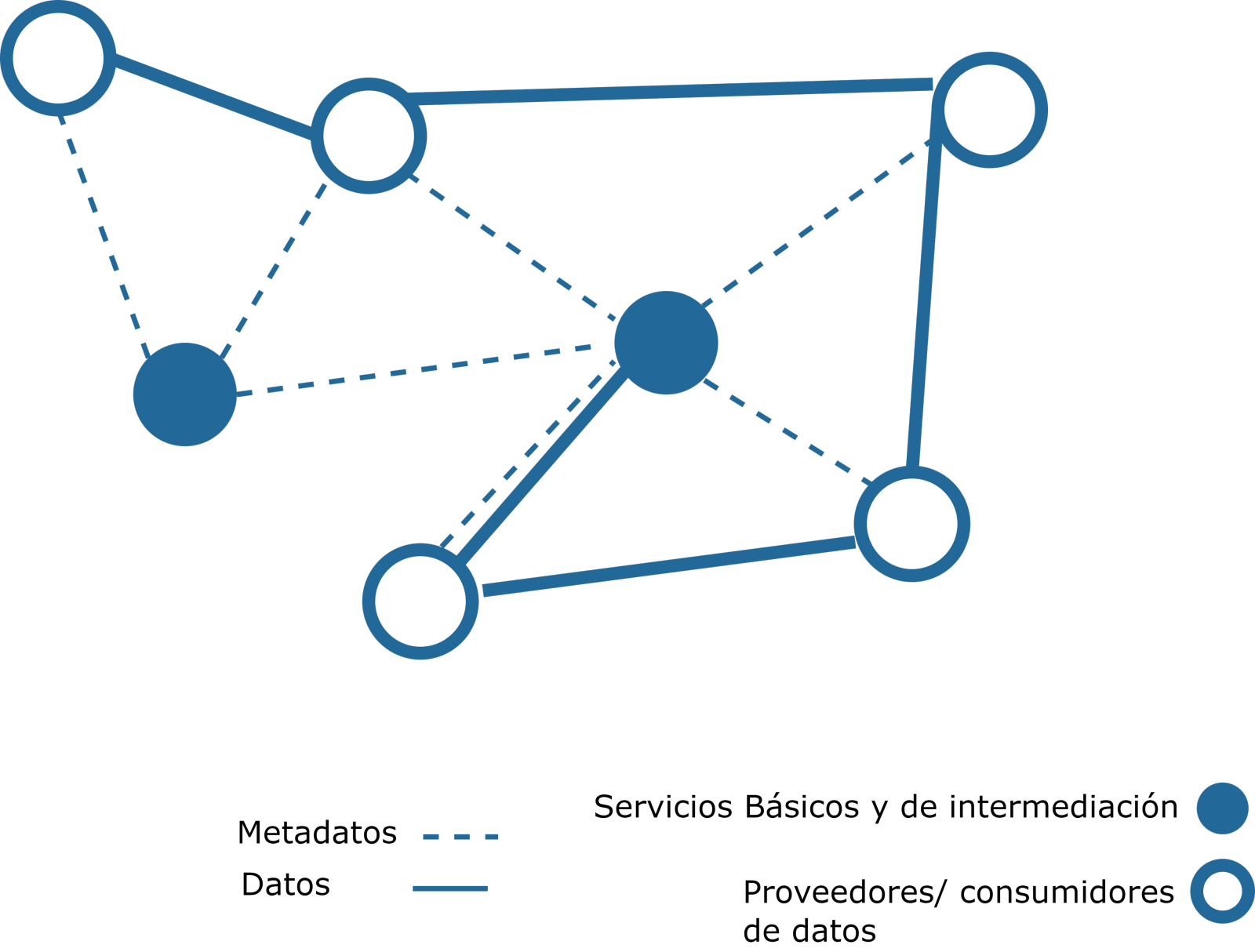
A data space is the place where value is generated around data through voluntary sharing in an environment of sovereignty, trust and security. The data space enables you to determine who accesses what data and under what conditions, thus facilitating the deployment of different use cases to meet different business needs. The data space functions as an open and heterogeneous environment of providers and consumers of data products, with no dominant players and no disproportionate barriers to entry and exit.
The data space is the place for sustainable value generation around data, a catalyst for innovation and business growth, allowing to identify market opportunities, anticipate trends, make better informed decisions, increase operational efficiency, develop transformative products and services or personalise customer experiences.
Within the concept of data space, and beyond a bilateral exchange of information, there is room for both centralised environments of information aggregation and generation of value-added services, with or without financial compensation, and more innovative data sharing environments (typically federated and distributed). The former can be seen as fundamental building blocks for the latter, and in any case, full interoperability of the deployed solutions and their future scalability should be sought.
The data space is the ideal scenario for deploying a variety of advanced technologies to efficiently explore data sets and turn them into information. This creates an environment conducive to innovation and process optimisation, resulting in a landscape in which information becomes a strategic resource for growth and informed decision-making. The data space enables the use of advanced analytics tools (business intelligence, big data, machine learning, deep learning, etc.), generative algorithms (LLM, GPT), process automation (RPA), and/or advanced data preservation techniques (DLTs).
In practice, a data provider (formally incorporated in the corresponding data space) will make its data products accessible through a catalogue, managed according to the indications of the data space promoter. When a participant wishes to access a product, it will look for the availability of such information, studying its conditions of access and use, as well as the appropriateness of its semantics and vocabulary. If the characteristics detailed in the catalogue meet his/her expectations, he/she will establish the appropriate negotiation and proceed to establish an effective transfer between supplier and consumer, in accordance with the technical conditions set out in the catalogue.
What does the data space offer to each type of participant?
There are four types of participants in a data space:
1) Data space promoter:
It is the driver of the sharing and operating environment, and will therefore be responsible for its governance and management (and may delegate some operational parts). It will therefore be the guarantor of the generation of community around the data space, articulating different business models and seeking and attracting new participants, thus dynamising innovation and the development of new value-added services.
Different business models can be generated within the data space. These include:
- Monetisation of data on a bilateral basis.
- Markets as a meeting point between suppliers and consumers.
- The marketing of software products or services for data analysis and exploitation.
- The facilitation of technological solutions to mediate the identification of participants or the exchange between them.
- The development of industrial platforms integrating the value chain.
- Making data openly available altruistically.

2) Providers of data sets and services:
They offer data products (both sets and services) within the contours of rights and obligations defined by the data space developer .
Thanks to cybersecurity and the sovereignty capabilities it provides, the barriers and risks associated with sharing are lowered, thus facilitating the generation of value and the return on the investment involved in making resources available. Moreover, the technological uncertainties linked to the deployment of innovative business models are partially mitigated by the use of standard frameworks and solutions (provided by the technology specifier and the technology provider, respectively).
Providers of data sets and services can opt for different revenue generation models, such as:
- Provide free access to the data, thus seeking to generate a high volume of traffic to attract sponsors or advertisers.
- Deploy a type of freemiun access free of charge for specific data and services, but at a cost for specific or higher quality services and data.
- Establish temporary or continuous licensing agreements.
- Define dynamic costing systems linked to timely demand or complexity of access
- Deploy a collaborative sharing system where access to other people's data is linked to sharing one's own data ( quid-pro-quomodel).
3) Consumers of data sets and services:
They consume data products within the contours of rights and obligations defined by the data space developer.
It allows them to benefit by incorporating the value of third-party data (from different suppliers) into their system by consolidating or combining it with their own data. The information and knowledge generated from this shared data makes it possible to solve business problems that would be unmanageable on an individual basis, adding value to the business itself.
The value proposition of the data consumer can go through:
- Acting on one's own behalf, for personal consumption and profit.
- Acting as a data broker, connecting organisations with fewer resources or maturity, and thus offering trust.
- It plays the role of a reuser, which is able to generate value-added services on the data space by reworking the information provided.
Precisely in the sense of risk mitigation and confidence building, the use of standard solutions (provided by the technology provider of the data space, which we will see below) serves to ensure service levels(business continuity) and the reduction of technological risks, as well as to avoid registration on multiple platforms or the management of complex and diverse authorisation and access processes.
4) Technology provider:
It is in charge of integrating and operating the technical solution that enables the deployment of the data space infrastructure (on behalf of, under the governance and management of the developer). This provider will carry out the development, configuration and parameterisation to implement the technical solution to deploy the data space, practically as a service ready for consumption. For this purpose, a basic physical infrastructure will be used, on top of which technological components will be added to enable adequate management of participants' identities, as well as all other functionalities that characterise the data space in question (and which will typically follow a reference architecture).
The provider will therefore make precise use of different enabling technologies for the governance and management of the data space, from the deployment of privacy-enhancing technologies to ensure the proper treatment of protected information, to tools to automate contractual compliance and guarantee sovereignty.
It is important to note that this figure of the "data space technology provider" does not coincide with that of the data technology service provider within the already operational data space itself. The former deploys and operates the technologies necessary to shape the ecosystem, within which the latter operates, offering ad-hoc solutions (which could in any case include the former organisation, as permitted by the competition regulations of the sector in which the data space operates, as well as its specific governance).